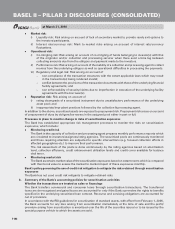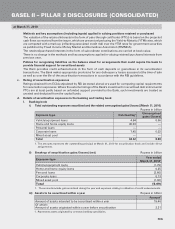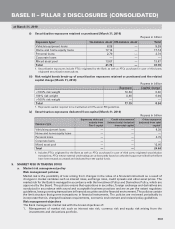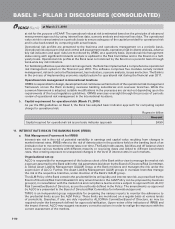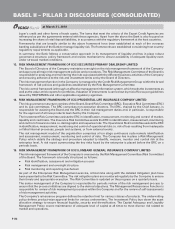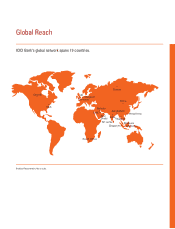ICICI Bank 2010 Annual Report Download - page 194
Download and view the complete annual report
Please find page 194 of the 2010 ICICI Bank annual report below. You can navigate through the pages in the report by either clicking on the pages listed below, or by using the keyword search tool below to find specific information within the annual report.
F114
buyer’s credit and other forms of trade assets. The loans that meet the criteria of the Export Credit Agencies are
refinanced as per the agreements entered with these agencies. Apart from the above the Bank is also focused on
increasing the share of retail deposit liabilities, in accordance with the regulatory framework at the host countries.
Frameworks that are broadly similar to the above framework have been established at each of the overseas
banking subsidiaries of the Bank to manage liquidity risk. The frameworks are established considering host country
regulatory requirements as applicable.
In summary, the Bank follows a conservative approach in its management of liquidity and has in place robust
governance structure, policy framework and review mechanism to ensure availability of adequate liquidity even
under stressed market conditions.
13. RISK MANAGEMENT FRAMEWORK OF ICICI SECURITIES PRIMARY DEALERSHIP LIMITED
The Board of Directors of the Company maintains oversight on the risk management framework of the Company
and approves all major risk management policies and procedures. The Risk Management Committee of the Board is
responsible for analysing and monitoring the risks associated with the different business activities of the Company
and ensuring adherence to the risk and investment limits set by the Board of Directors.
The risk management function in the Company is managed by the Credit Risk Management Group within the broad
framework of risk policies and guidelines established by the Risk Management Committee.
The risk control framework is through an effective management information system, which tracks the investments as
well as the value at risk reports for portfolios. Valuation of instruments is carried out by mid-office as per guidelines
issued by RBI/FIMMDA and other applicable regulatory agencies.
14. RISK MANAGEMENT FRAMEWORK OF ICICI PRUDENTIAL LIFE INSURANCE COMPANY LIMITED
The risk governance structure consists of the Board, Board Risk Committee (BRC), Executive Risk Committee (ERC)
and its sub committees. The BRC comprises non-executive directors. The ERC, chaired by the Chief Actuary, is
responsible for assisting the Board and the BRC in their risk management duties and, in particular, is responsible
for the approval of all new products launched by the Company.
The Investment Risk Committee assists the ERC in identification, measurement, monitoring and control of market,
liquidity and credit risks. The Insurance Risk Committee assists the ERC in identification, measurement, monitoring
and control of insurance risks i.e. demographic and expense risks. The Operational Risk Committee assists the ERC
in identification, measurement, monitoring and control of operational risks i.e. risk of loss resulting from inadequate
or failed internal processes, people and systems, or from external events.
The risk management model of the organisation comprises a four stage continuous cycle namely identification
and assessment, measurement, monitoring and control of risks. The Company has in place a Risk Management
Policy which details the strategy and procedure adopted to identify, measure, monitor and control risk at the
enterprise level. A risk report summarising the key risks faced by the enterprise is placed before the BRC on a
periodic basis.
15. RISK MANAGEMENT FRAMEWORK OF ICICI LOMBARD GENERAL INSURANCE COMPANY LIMITED
The risk management framework of the Company is overseen by the Risk Management Committee (Risk Committee)
of the Board. The framework is broadly structured as follows:
z Risk identification, assessment and mitigation process
z Risk management and oversight structure
z Risk monitoring and reporting mechanism
As part of the Enterprises Risk Management exercise, critical risks along with the detailed mitigation plan have
been presented to the Risk Committee. The risk mitigation plans are monitored regularly by the Company to ensure
their timely and appropriate execution. The Risk Committee is updated on the progress on a quarterly basis.
The senior management of the Company is responsible for periodic review of the risk management process to
ensure that the process initiatives are aligned to the desired objectives. The Management Reassurance Function is
responsible for review of risk management processes within the Company and for the review of self-assessments
of risk management activities.
The Company’s reinsurance program defines the retention limit for various classes of products. The underwriting
policy defines product-wise approval limits for various underwriters. The Investment Policy lays down the asset
allocation strategy to ensure financial liquidity, security and diversification. The Capital Adequacy and Liquidity
Management Policy covers maintenance of adequate level of capital at all times to meet diverse risk related to
market and operations.
BASEL II – PILLAR 3 DISCLOSURES (CONSOLIDATED)
at March 31, 2010


